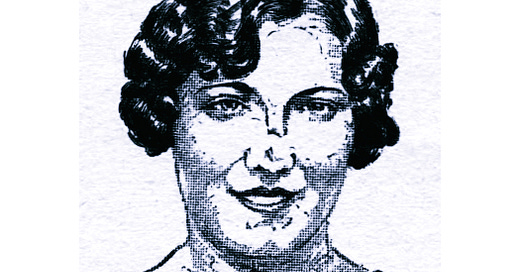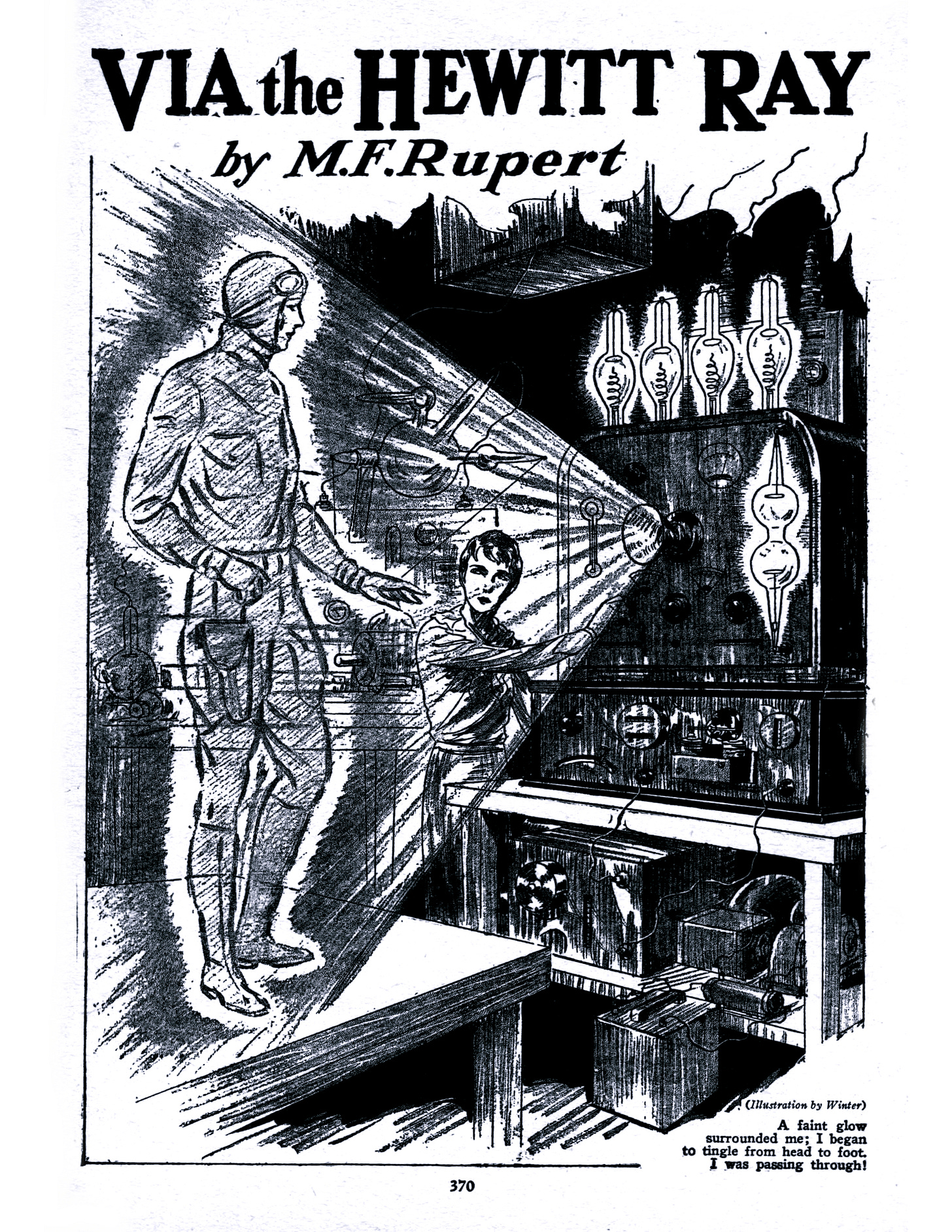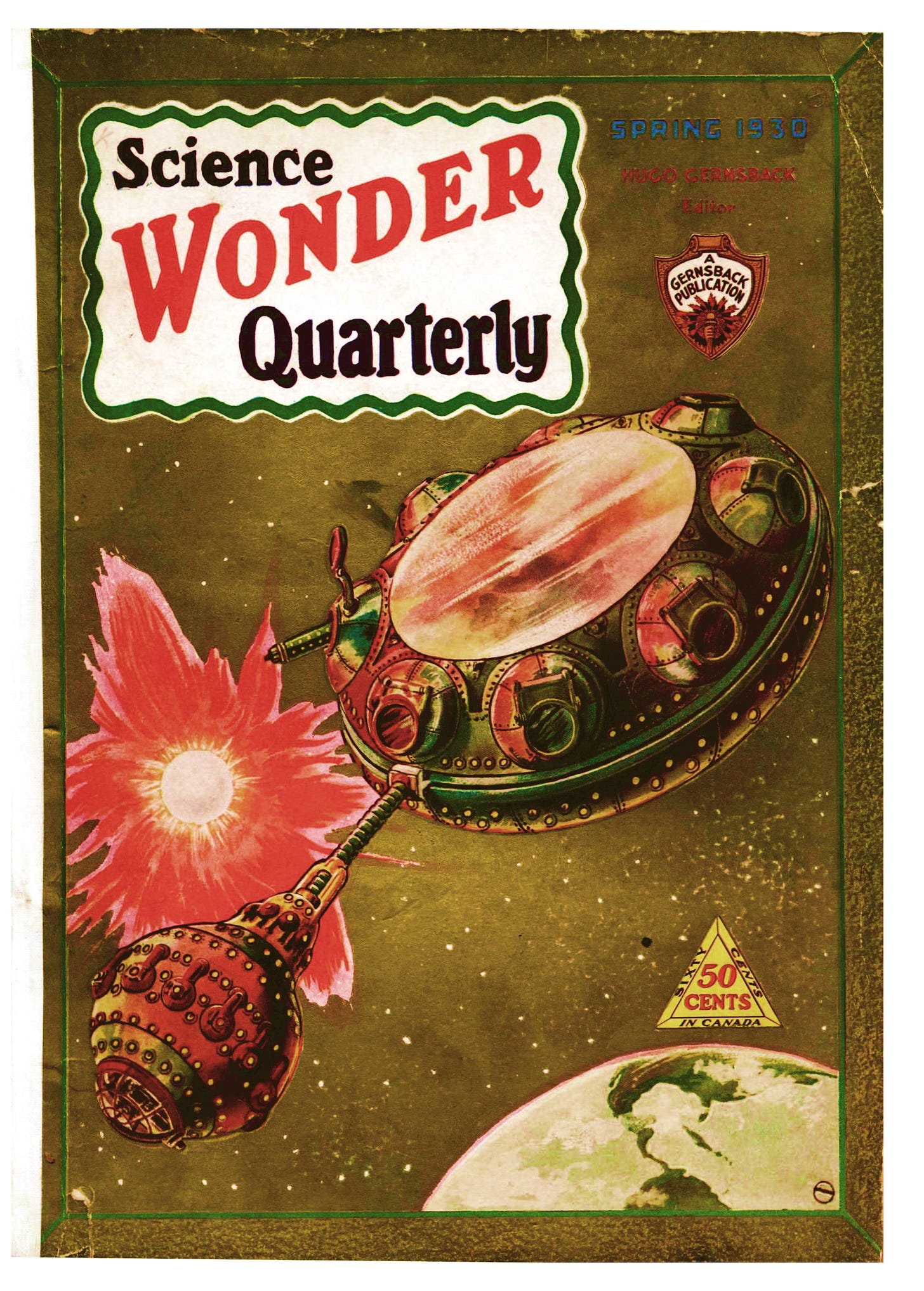This week I’m going to tell you about a singular story—“Via the Hewitt Ray”—written by (Miss) M. F. Rupert of Chicago. The story was published in SCIENCE WONDER QUARTERLY in the Spring 1930 issue. According to ISFDB, this was Miss Rupert’s only published science fiction story. The story is mentioned in Mike Ashley’s “The Feminine Future: Early Science Fiction by Women Writers” (Dover, 2015) and is sometimes categorized as “feminist utopian science fiction.”
There are many writers interested in early feminist utopian stories. They want to compare and contrast contemporary fiction with the fiction of the past. They also want to highlight, with bright underlining, either how wrong the suppositions were or how women were suffering at the time. Sometimes, it’s just an attempt to suggest that women are much better off now—post 1970’s feminism.
I’m not out to make any of those points, although I do find notions of 1920’s utopias (not feminist, just general) interesting. These types of utopias often have a humanist view of the future. People are beautiful, fit and competent. They often think of the human race before themselves and, of course, men and women are equals in all things. They also seem to enjoy their leisure time, playing sports, traveling, and having adventures which “futuristic” technologies make easy. There is something both naïve and rejuvenating about these types of tales. My favorite example of a 1920’s utopian story is —“Into the 28th Century” by Lilith Lorraine published in SCIENCE WONDER QUARTERLY, Winter 1930. (Interestingly, the issue previous to the one containing “Via the Hewitt Ray.”) I will speak more about Miss Lorraine’s story in a future post.
The plot of “Via the Hewitt Ray” is an adventure set in the near future. A scientist named, John Hewitt, invents a light-wave machine allowing for near instantaneous travel. His machine starts receiving odd Fraunhofer Lines (spectral absorption lines) on the screen, every day at the same time. This is a message from another dimension. Hewitt decides to reconfigure his machine to project a person into the dimension where the unknown messages are coming from. He leaves his daughter, Lucile, a letter telling her about his plans and his wish that he’ll be able to make contact with her from the other dimension.
Up to this point, the story is not at all unusual. But as the tale shifts to Lucile’s story, things become more interesting. Lucile decides to go in search of her missing father and therein hangs the tale. Our female hero is a competent woman, a professional pilot working for a commercial airline. Her viewpoint is distinctly feminine, with a light touch. She’s no militant, nor a man in disguise. Most of the characters in the story are women. Lucile’s school friend is a scientist—Marian Wells—and she helps Lucile with her plans to go into the alternate dimension.
As she prepares to follow her father, Lucile tells us: "I had dressed myself in my flying togs and strapped a 45 Colt and cartridges around me. A few clean handkerchiefs and a couple of packages of cigarettes completed my personal luggage." Definitely a 1920’s adventuress and I love the detail of the handkerchiefs!
Upon arrival in the other dimension she finds strange creatures and savage beast-like men. Lucile is brave and yet we see her frightened, too. She shoots two giant beasts while trembling, showing that she’s a practical woman but with realistic emotions. Later, she’s captured by the beast-men and bravely shoots one of her savage captors then escapes in a strange aircraft, whose female pilot had been killed by a primitive arrow. She flies free until caught by a radio beam which remotely brings her into a city inside a mountain—City 43 of the “Secondary Evolutionary plane.”
This is a futuristic “wonder-world” with translation helmets, gravity lifts, and showers with radio-active rays which “cleanse the skin and penetrate the pores, revivifying the body with new life and strength.” Here are miracles of science including a woman with an artificial heart, and immense insect servants specially bred to be non-aggressive.
Mavia, her first contact in City 43, says some interesting things in passing. Here is the first: “Oh, you are from the third dimension? I had no idea that the beings of the third dimension had evolved to the point of inter-dimensional travel.” Well!
The women are “fine, intelligent, well-developed, good-looking women” who stand least six and a half feet tall. Lucile says she can stand under the arm of any of them. Mavia explains: "This world in which you now find yourself is the fourth dimension. In it are the beings of the First, Second and Third Evolutionary planes. The first consists of savages of a very low order--just now emerging from the beast stage into the human....The Secondary Evolutionary plane consists of ourselves. We are seventy-nine cities. Each city is like the you are now in…our cities are built inside the mountains as a means of defense against the first and third planes, who are continually waging war against us. Our plane consists almost entirely of women. We just keep enough men to maintain the race....” There had previously been a war and an overthrow of the male-dominated society. Lucile questions Mavia about producing young without males. Mavia tells her that they tried it and the results were monstrous. So they went back to age-old methods. The remaining males were put through rigorous testing, mental and physical. Those of high average intelligence were kept as reproducing males. Those whose intelligence was below their standard were sterilized and kept for recreational purposes. All women are required to have two children for the city. Lucile asks about the non-reproducing males and why they keep them. Mavia answers as follows: "We changed a lot of things but we were unable, without danger to the future of our race, to change the fundamentals of natural instincts. When we women have borne two children to the race we are not allowed to reproduce a third time. Nevertheless the old biological urge returns and then we find use for the sterile male."
Lucile witnesses the trial of an insubordinate reproducing male—Joburza. "Slightly built but straight as a sapling, he stood before us. He was very good-looking.” Joburza insists he’d rather die than submit to the reproduction protocols. He states that he hates the women and their system of governance. But the women, cruelly, tell him that they will put him in the electro-coma room and reduce his intelligence, then sterilize him and leave him with the men of the 13th tier (the sterilized men’s floor.) He asks for pity and Lucile speaks up. She asks the tribunal if she can have the prisoner to do with as she wills. They ask her why she wants him and she answers quickly that she wants to take him back to the third dimension for scientific experiments. The judges agree and Lucile hides her elation. Joburza is suspicious of more cruelty but Lucile speaks with him alone and tells him that she only wants to help him.
The women locate Lucile’s lost father in the city of the Third Evolution—the women’s enemies. The women plan to rescue Lucile’s father and after that they must return to their own dimension. “We do not care to take on the responsibility of trying to fit in our lives with those of an odd dimension nor to take the time and trouble to fit the odd dimensioners into our life.” I think this is a very practical and interesting viewpoint which seems very feminine to me.
Lucile is curious as to why she can see the people of the 4th dimension just as she would a person of the 3rd dimension. She asks Mavia about it. "I always understood that if a being of one dimension passed through into another dimension, he would find everything appearing to him at odd angles or cross sections. How is it that you seem to have the same number of dimensions as I?"
Mavia replies: "…here is something that the theorists have not taken into consideration. When the object or person passes from one dimension into another…they immediately take on the dimensional proportions of the new plane of existence. For example, you, a three-dimensional being, in passing into the fourth dimension, took on an extra dimension, which you will lose as you pass back to your own plane. That is why we look normal to you and you look normal to me. Whereas, if this Hewitt Ray of yours permitted you to remain in the third dimension and gaze through into the fourth, then you would have seen us in what would appear to you as a cross section or, as you say, in peculiar angles." Very interesting thought, isn’t it?
Soon, women scouts free Lucile’s father, John Hewitt, from the city of the “Third Evolution” and return him to the city of women. It’s a happy reunion and Hewitt tells Lucile that the Third Evolution men (“Thirds” as they call themselves) are highly scientific and he found them fascinating. Still, he’s glad to be rescued and happy to see his daughter.
Lucile wants to help the women with their war against the Thirds. She suggests using the Hewitt Ray to beam their army directly into the Third’s city. There is a mighty battle and eventually the women triumph, with the help of the Hewitt Ray machine and Lucile, who is a fierce fighter alongside the other women soldiers.
After the battle is over, Hewitt, Lucile and Joburza return to our 3rd dimension. There they find Lucile’s scientist friend, Marian, still manning the controls. After that, there are a few pieces to wrap up. "Joburza, whom I promptly re-christened John, fitted himself easily into our life. He learned our language quickly but spoke with a curiously quaint accent. Dad, discovering that he had an aptitude for science, readily took him into his laboratory as a pupil-assistant.” Lucile confesses to liking John but “he exasperated me by his air of timidity with women.” She tries to get him to get over this and eventually tells him to brace up and realize that men are in every way superior to women. (In an aside she adds, “May my sisters in feminism forgive the lies. I had to be drastic.”) He takes the hint, grabs Lucile and kisses her. Her father thinks this is all too funny as John has taken her non-feminist advice to heart. And she doesn’t mind either because, well…she has a thing for John, too.
It’d be easy to call this story naïve and old-fashioned for indeed it is. But the simple charm of it, told by a female storyteller to an early science fiction audience, is wonderful. There’s a feeling to 1920’s science fiction which you get if you read enough of it. It’s a bit whizz-bang but in a quiet and dignified way. As stories progress further into the pulp era, things get more and more high-octane. Eventually, they roar the motor so high they must shift away from pure adventure altogether and move towards the psychological tales we see in the mid-late 1950’s. But back in 1930 we can still feel those leisurely, dignified 1920’s plots and pacing. And it’s nice to get a woman’s perspective, especially one like Miss M. F. Rupert of Chicago who seems to have thrown all her intentions into this one lovely, little story.
This is the Rocketeer signing off for today.








